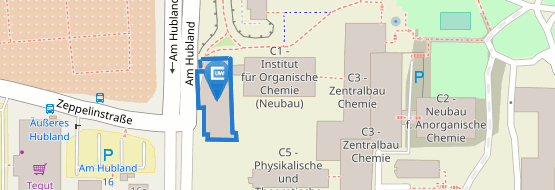DFG - GEPRIS - Einfluss von Endokrinen Disruptoren aus der Umwelt, Ernährung und Lebensstil auf Sexualhormonspiegel und deren Wirkung im Brustgewebe indischer und deutscher Frauen

Dr. Kausar Mahmood Ansari
Food Toxicology Laboratory, CSIR-Indian Institute of Toxicology Research, Lucknow, India
Prof. Dr. Vijay Kumar
Department of Surgical Oncology, King George's Medical University, Lucknow, India
Prof. Dr. Vijay Kuma
Department of Plastic & Reconstructive Surgery, King George's Medical University, Lucknow, India
Prof. Dr Gaurav Agarwal and Prof. Dr Anjali Mishra
Department of Endocrine & Breast Surgery, Sanjay Gandhi Postgraduate Institute of Medical Sciences, Lucknow, India
Dr. Wolf-Gunter Steinmetz
Praxis für Ästhetische und Plastische Chirurgie, Würzburg
Prof. Dr. Katja Ickstadt
Lehrstuhl für Mathematische Statistik und biometrische Anwendungen, Technische Universität Dortmund, Dortmund
Wunder J, Pemp D, Cecil A, Mahdiani M, Hauptstein R, Schmalbach K, Geppert LN, Ickstadt K, Esch HL, Dandekar T, Lehmann L (2022). Influence of breast cancer risk factors on proliferation and DNA damage in human breast glandular tissues: role of intracellular estrogen levels, oxidative stress and estrogen biotransformation. Arch Toxicol. doi.org/10.1007/s00204-021-03198-7.
Pemp D, Geppert LN, Wigmann C, Kleider C, Hauptstein R, Schmalbach K, Ickstadt K, Esch HL, Lehmann L (2020). Influence of breast cancer risk factors and intramammary biotransformation on estrogen homeostasis in the human breast. Arch Toxicol. doi.org/10.1007/s00204-020-02807-1.
Pemp D, Kleider C, Schmalbach K, Hauptstein R, Geppert LN, Köllmann C, Ickstadt K, Eckert P, Neshkova I, Jakubietz R, Esch HL, Lehmann L (2019). Qualitative and quantitative differences in estrogen biotransformation in human breast glandular and adipose tissues: implications for studies using mammary biospecimens. Arch Toxicol. doi.org/10.1007/s00204-019-02564-w.
Prof. Maarten C. Bosland
Department of Pathology, College of Medicine, Unversity of Illinois at Chicago, Chicago, USA
Pemp D, Esch HL, Hauptstein R, Möller FJ, Zierau O, Bosland MC, Geppert LN, Kleider C, Schlereth K, Vollmer G, Lehmann L (2019). Novel insight in estrogen homeostasis and bioactivity in the ACI rat model of estrogen-induced mammary gland carcinogenesis. Arch Toxicol. Volume 93 (7), 1979-92. doi: 10.1007/s00204-019-02483-w.
Möller F, Pemp D, Soukup S, Wende K, Zhang X, Zierau O, Muders M, Bosland M, Kulling S, Lehmann L, Vollmer G (2016). Soy isoflavone exposure through all life stages accelerates 17β-estradiol-induced mammary tumor onset and growth, yet reduces tumor burden, in ACI rats. Arch. Toxicol. pp. 1907-1916.
Prof. Dr. med. Peter Eckert
Klinik für Ästhetische und Plastische Chirurgie, Würzburg
Pemp D, Kleider C, Schmalbach K, Hauptstein R, Geppert LN, Köllmann C, Ickstadt K, Eckert P, Neshkova I, Jakubietz R, Esch HL, Lehmann L (2019). Qualitative and quantitative differences in estrogen biotransformation in human breast glandular and adipose tissues: implications for studies using mammary biospecimens. Arch Toxicol. doi.org/10.1007/s00204-019-02564-w.
Prof. Dr. Günter Vollmer
Lehrstuhl für Molekulare Zellphysiologie und Endokrinologie, Universität Dresden, Dresden
Pemp D, Esch HL, Hauptstein R, Möller FJ, Zierau O, Bosland MC, Geppert LN, Kleider C, Schlereth K, Vollmer G, Lehmann L (2019). Novel insight in estrogen homeostasis and bioactivity in the ACI rat model of estrogen-induced mammary gland carcinogenesis. Arch Toxicol. Volume 93 (7), 1979-92. doi: 10.1007/s00204-019-02483-w.
Möller F, Pemp D, Soukup S, Wende K, Zhang X, Zierau O, Muders M, Bosland M, Kulling S, Lehmann L, Vollmer G (2016). Soy isoflavone exposure through all life stages accelerates 17β-estradiol-induced mammary tumor onset and growth, yet reduces tumor burden, in ACI rats. Arch. Toxicol. pp. 1907-1916. doi:10.1007/s00204-016-1674-2.
Blei T, Soukup ST, Schmalbach K, Pudenz M, Möller FJ, Egert B, Wörtz N, Kurrat A, Müller D, Vollmer G, Gerhäuser C, Lehmann L, Kulling SE, Diel P. Dose-dependent effects of isoflavone exposure during early lifetime on the rat mammary gland: Studies on estrogen sensitivity, isoflavone metabolism and DNA methylation. Mol Nutr Food Res. 2014 Nov 20. 59(2):270-83 doi: 10.1002/mnfr.201400480.
Dr. Georg Kretzschmar
Lehrstuhl für Molekulare Zellphysiologie und Endokrinologie, Universität Dresden, Dresden
Helle J, Keiler AM, Zierau O, Dörfelt P, Vollmer G, Lehmann L, Chittur SV, Tenniswood M, Welsh J, Kretzschmar G (2017). Effects of the aryl hydrocarbon receptor agonist 3-methylcholanthrene on the 17β-estradiol regulated mRNA transcriptome of the rat uterus. J Steroid Biochem Mol Biol 171:133-143. doi: 10.1016/j.jsbmb.2017.03.004.
Isocross - Isoflavones: Cross-species comparison of metabolism, estrogen sensitivity, epigenetics, and carcinogenesis

Blei T, Soukup ST, Schmalbach K, Pudenz M, Möller FJ, Egert B, Wörtz N, Kurrat A, Müller D, Vollmer G, Gerhäuser C, Lehmann L, Kulling SE, Diel P. Dose-dependent effects of isoflavone exposure during early lifetime on the rat mammary gland: Studies on estrogen sensitivity, isoflavone metabolism and DNA methylation. Mol Nutr Food Res. 2014 Nov 20. 59(2):270-83 doi: 10.1002/mnfr.201400480.
Prof. Larry Robertson und Prof. Gabriele Ludewig
Department of Occupational and Environmental Health, College of Public Health, The University of Iowa, Iowa City, USA
Jacobus JA, Wang B, Maddox C, Esch H, Lehmann L, Robertson LW, Wang K, Kirby P, Ludewig G (2010). 3-Methylcholanthrene (3-MC) and 4-Chlorobiphenyl (PCB3) genotoxicity is gender-related in Fischer 344 transgenic rats. Environ. Int. 36, 970-979.
Ludewig G, Lehmann L, Esch H, Robertson LW (2008). Metabolic Activation of PCBs to Carcinogens in Vivo - A Review. Environ. Toxicol. Pharmacol. 25, 241-246.doi: 10.1016/j.etap.2007.10.029.
Zettner MA, Flor S, Ludewig G, Wagner J, Robertson LW, Lehmann L (2007). Quinoid metabolites of 4-monochlorobiphenyl (PCB3) induce gene mutations in cultured Chinese hamster V79 cells. Toxicol. Sci. 100, 88-98. doi: 10.1093/toxsci/kfm204.




